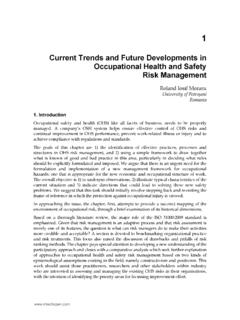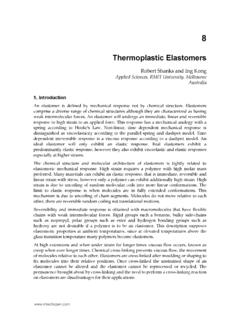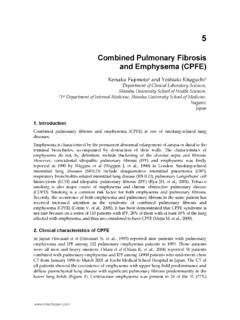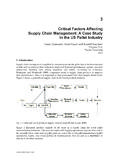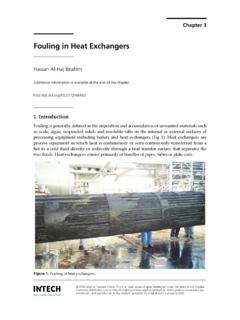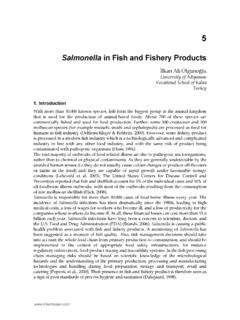Transcription of Selection, Design and Construction of Offshore Wind ...
1 10 selection , Design and Construction of Offshore Wind Turbine Foundations Sanjeev Malhotra, PE, GE Parsons Brinckerhoff, Inc. United States of America 1. Introduction In the past twenty five years, European nations have led the way in the development of Offshore wind farms. However, development in Offshore wind energy is picking speed in other continents as well. More recently, there has been explosive growth in investment in the clean energy sector, with onshore and Offshore wind power taking by far the largest share of that investment.
2 About 50 billion US dollars were invested each year since 2007. Although economic crises may have impeded investment in 2010. In the last few years nearly 30 to 40 percent of all new installed power generation capacity in Europe and the United States is attributed to wind energy. The European Wind Energy Association estimates that between 20 GW and 40 GW of Offshore wind energy capacity will be operating in the European Union by 2020. The US Department of Energy predicts that 50 GW of installed Offshore wind energy will be developed in the next 20 years (NWTC, 2006).
3 This means at least US$100 billion of capital investment with about US$50 billion going to Offshore Design and Construction contracts. In the United States, Offshore wind power development has not been a focus area because there is great potential for wind power on land. However, high quality onshore wind resources are mostly located in the Midwest and Central United States while the demand centers are located along the coasts, thereby making the cost of transmission high. On the northeast coast of the United States, Offshore development is an attractive alternative because electricity costs are high and transmission line Construction from the mid-west faces many obstacles.
4 Higher quality wind resources, proximity to coastal population centers, potential for reducing land use, aesthetic concerns, and ease of transportation and installation are a few of the compelling reasons why power companies are turning their attention to Offshore development. Offshore turbines are being made larger to economize in the foundation and power collection costs. As the technology for wind turbines improves, the industry has developed wind turbines with rotor diameters as large as 150 m and power ratings of over MW to 10 MW.
5 As increasing number of wind farms are being planned 15 to 50 km from shore in water depths of over 50 m, the combination of water depth, the increasing wind tower heights and rotor blade diameters create loads that complicate the foundation Design and consequently place a greater burden on the engineer to develop more innovative and cost-effective foundations and support structures. Moreover, Offshore foundations are exposed to additional loads such as ocean currents, storm wave loading, ice loads and potential ship impact loads.
6 All of these factors pose significant challenges in the Wind Turbines 232 Design and Construction of wind turbine support structures and foundations. This chapter summarizes current practices in selecting and designing such foundations. 2. Background Wind turbine farm layout Primary components of a typical Offshore wind farm include several wind turbines located in the water, connected by a series of cables to an Offshore transformer station which in turn is connected by an undersea cable to an onshore transformer station linked to the existing power grid (Figure 1).
7 The wind turbines are usually spaced laterally at several (4 to 8) times the rotor diameter and staggered so as to minimize wake effects. Placing turbines closer reduces the quantity of electric cable required but it increases turbulence and wake effects thereby reducing power generation. Therefore, laying out wind turbine farms includes minimizing the length of cabling required yet maximizing power generation so as to optimize costs per unit of power produced. Fig. 1. Wind Farm Components and their Layout, (Malhotra, 2007c) Wind turbine components The components of a wind turbine system (Figure 2) include the foundation, the support structure , the transition piece, the tower, the rotor blades and the nacelle.
8 The foundation system and support structure , used to keep the turbine in its proper position while being exposed to the forces of nature such as wind and sea waves, can be made using a variety of materials such as reinforced concrete or steel. Support structures connect the transition piece or tower to the foundation at seabed level. In some cases, the foundations serve as support structures as well by extending from the seabed level to above the water level and connecting directly to the transition piece or tower. The transition piece connects the tower to the support structure or foundation.
9 The transition piece also provides a means to correct any misalignment of the foundation that may have occurred during installation. The towers are made of steel plate rolled into conical subsections that are cut and rolled into the right shape, and then welded together. The nacelles contain the key electro-mechanical components of the wind turbine, including the gearbox and generator. The rotor blades are made of fiberglass mats impregnated with polyester or carbon fiber composites. The power cable from each turbine is inserted in a J shaped plastic tube which carries the cable to the cable trench in the seabed.
10 , Design and Construction of Offshore Wind Turbine Foundations 233 Fig. 2. Wind Turbine System Components (Malhotra, 2007c) Wind turbine operation As wind flows through a turbine it forces the rotor blades to rotate, transforming kinetic energy of the wind to mechanical energy of the rotating turbine. The rotation of the turbine drives a shaft which through a gear box drives a power generator which generates current through the principal of electromagnetic induction. The shaft, gearbox and generator are located in the nacelle.
